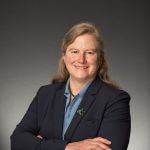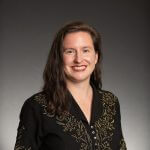Justinn Overton
Mt Laurel, Alabama
This interview was conducted by Carly Schmidt on January 23, 2023. Learn more about Justinn’s work at https://coosariver.org/.
Transcript
What is your role at Coosa Riverkeeper?
I am the Executive Director and Staff Riverkeeper.
What does it look like when both those things exist at the same time?
I was the Executive Director first and took on the Riverkeeper role in 2020. For me, it’s been a positive thing. I come from an environmental science background and was really missing the fieldwork. Doing Quickbooks and development is super important to our mission, but my heart is in the field work. It’s been good, for the most part, because I’m situated between two sides of my work self. Work life balance is hard in any position if you’re passionate about what you do, so I feel like I would have that same struggle regardless of what I do if I care about the work.
Being a Riverkeeper is a tough job, especially when our rivers are under constant threat. What actions do you take that remind you of your positive impact and prevent burnout?
A couple different things. As a manager, it’s really important that I get my people out in the field. We need days that are not just investigating pollution but are just days on the boat enjoying the beauty of the Coosa. On Friday, I took my team out on the boat because we just needed sunshine. We’ve been doing a lot of desk work and we needed to laugh and spend time together. I’m a really big proponent of caring for people’s emotional health as well as their workflow. I’ll admit I’m not always the best example of work-life balance myself.
I try to instill joy because this work can be really overwhelming. The Coosa River was named the 5th most endangered river last year and has been listed 3 times in total. This was the very first place polychlorinated biphenyls (PCBs) were ever commercially manufactured. Plus, we’ve got over 30 fish consumption advisories, rampant wastewater treatment plant failures, PFAS contamination, sedimentation, the list goes on… Like you said, we’re under constant threat. That’s why celebrating is so important.
But for me, as a person, it’s hard. I struggle because I’ve been with the organization for so long and I want us to be sustainable. Part of that is me taking care of myself as a leader. And shoutout to Diana Toledo who does this really well. This is not a paid ad, Diana instilled a lot of helpful tools in me when she lead our strategic planning in 2018 that prepared me for so many future fights and changes within the organization. It easier for me to say no to things and put up boundaries because our strategic plan is really malleable to address the Coosa’s issues, but it’s structured enough that I know when to say no to a new opportunity, and also when to say, “hell yes!”. There are a lot of organizations who just don’t understand strategic planning, but for me it’s this guiding document that brings me back to center.
You’ve been with Coosa Riverkeeper for 10 years. How have your priorities and focus areas changed since you started, and what are your most pressing issues now in terms of threats to the river and surrounding communities?
When I started, the organization was in a sink or swim situation, we were just so new. I was the part-time Director of Development, then promoted to Executive Director at 23. It speaks volumes that the Board allowed me to grow with the organization. I feel very grateful that I’ve been able to help facilitate our growth, but really that growth comes from my team. I often get to talk in front of the camera, but my staff is the backbone of our work. Nothing felt strategic at the beginning because we just needed to make payroll, and that was a hard cycle to get out, but that’s the reality of a lot of small nonprofits.
Now, I’m really focused on broadening our scope. The beginning was all about swim safety through our bacteriological monitoring program Swim Guide and safe fish through our Fish Guide program and making the river healthier. We’re expanding into environmental education and legislative work. We have a huge PFAS problem. The upper part of the Coosa River system has some of the highest concentrations of PFAS in the country and we’re getting that pollution downstream. That will continue to be an important issue. PCB remediation is also a big one, figuring out what remediation strategy will be best for the river, the critters, and the public.
I’m a huge proponent of Right to Know issues. I work in Alabama and our state motto is “We Dare to Defend our Rights,” but there are so many things that Alabamians don’t know about like where sewage enters our waterway or where fish are safe to eat. Focusing on that value, especially in the Southern culture, has allowed us to gain new allies that are non-traditional in the environmental or river advocacy landscape.
How did you get out of the payroll cycle?
Stubbornness. Having supportive family and finding the right Board and staff to create a secure organization. Now we’re in a different place financially, as an organization, but the fear is still there because the beginning was so hard. We certainly had angel donors in those early days that made substantial gifts. For instance, our previous patrol truck was a Chevy Silverado that was falling apart. One of the doors wouldn’t close all the way, rain would come in through the doors, it was bad. A donor called out of nowhere and said, “I have $50,000, what do you need?” And we needed a pickup truck! This was someone who gave $250 the previous year, and I picked up the phone and called him. The next year, he gave $50,000. It’s important for people to genuinely thank their donors because gratitude really matters. We’ve also used a lot of pro bono services. Catchafire is great, Environmental Law Institute, Thriving Earth Exchange. There are so many great resources like River Network out there that are intended to connect us with experts. Using your resources and being willing to say that you need help, and not submit to the panic, is really helpful in those moments.
Brenna Goggin (Director of Leadership Development at River Network) recently came out to Alabama to facilitate a strategic planning retreat. What goals did you have coming into this session and did you end up meeting these goals?
This strategic planning retreat was for Waterkeepers Alabama, which is a regional entity of the 10 Waterkeepers that have jurisdiction in Alabama. I’m the former President, but we’ve since moved to a new leadership model. I needed someone to get all these personalities in a room and decide what we want to work on together in a way that doesn’t pull too many resources from any one organization. I know all these people, so I wanted to be able to contribute to the conversation instead of facilitating it. It’s really important to have a third-party person come in that can deal with the sticky bits that come up in strategic planning, but who can also tease out what everyone is trying to say and find commonalities. We absolutely were able to get that accomplished.
Water organizations could really benefit from the type of programming that River Network offers about how to sustain an organization and be a good, effective leader. It’s not just about fighting pollution, although that’s obviously critically important, we need effective teams, long-range strategies, and succession planning too.
What is this new leadership model that’s changed the game for this partnership?
Before it was a President and Vice President, but we moved into a leadership model that has 5 organizations at the helm that each house 1 or 2 of our major goals and objectives. One organization is going to organize our data, another will plan our retreats. The idea is that it will be more efficient by spreading out the workload among the groups that have the capacity to contribute, while also not having the largest organizations dominate or take on most of the work. It didn’t feel equitable in that way.
If you could ask the network one question to get some guidance on your current work, what would you ask them?
There’s a huge graphite mine coming into my watershed, and there’s so much information out there on critical mineral extraction that’s not relevant to what we have going on in my watershed. I’ve reached out to many organizations like Waterkeeper Alliance, Earthworks, I’ve done my due diligence, but I would love to talk to somebody that has experience fighting critical mineral extraction on the East Coast. Most of the resources are dealing with the West Coast on public land, which is entirely different.
About
Justinn Overton is the Executive Director and Riverkeeper at Coosa Riverkeeper, where she fights everyday for swimmable, drinkable, and fishable water for Alabamians. She patrols the watershed, tackles pollution, and leads our investigative and legislative efforts while guiding staff and Board of Directors.
In 2024, she was recognized by River Network as a National River Hero. She has also been awarded the State Alabama River Hero award by Alabama Rivers Alliance. In 2015, she was named one of Southern Living’s “Women of Worth,” and in 2017, she starred in a Voices for Clean Air campaign celebrating her passion for water and environmental justice.
Justinn graduated magna cum laude in Environmental Advocacy from the University of Alabama and earned a Master’s Certificate in Non-Profit Management.
When she’s not saving the river, Justinn keeps her many boats and feet wet with lots of swimmin’, canoe camping, and hiking. She is also a registered yoga teacher, enjoys dancing to the Grateful Dead, and lovin’ on her dog, Stella Blue.







